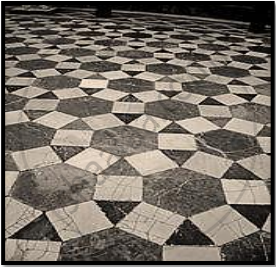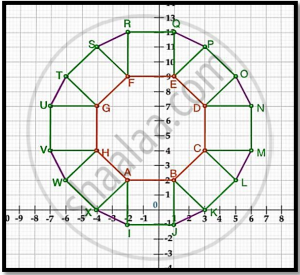Advertisements
Advertisements
Question
If (−2, 3), (4, −3) and (4, 5) are the mid-points of the sides of a triangle, find the coordinates of its centroid.
Solution
Let ΔABC be ant triangle such that P (−2, 3); Q (4,−3) and R (4, 5) are the mid-points of the sides AB, BC, CA respectively.
We have to find the co-ordinates of the centroid of the triangle.
Let the vertices of the triangle be`A(x_1,y_1);B(x_2,y_2);C(x_3,y_3)`
In general to find the mid-point p(x,y) of two points`A(x_1,y_1)`and`B(x_2,y_2)` we use section formula as,
`p(x,y)=((x_1+x_2)/2,(y_1+y_2)/2)`
So, co-ordinates of P,
`(-2,3)=((x_1+x_2)/2,(y_1+y_2)/2)`
Equate the x component on both the sides to get,
`x_1+x_2=-4` .........(1)
Similarly,
`y_1+y_2=6` ..........(2)
Similary, co-ordinates of Q
`(4,-3)=((x_3+x_2)/2,(y_3+y_2)/2)`
Equate the x component on both the sides to get,
`x_3+x_2=8`.........(3)
Similarly,
`y_3+y_2=-6 `..........(4)
Equate the x componet on both the sides to get,
`x_3+x_1=8`..........(5)
Similarly,
`y_3+y_1=10`..........(6)
Add equation (1) (3) and (5) to get,
`2(x_1+x_2+x_3)=12 `
`x_1+x_2+x_3 =6`
Similarly, add equation (2) (4) and (6) to get,
`2(y_1+y_2+y_3)=10`
`y_1+y_2+y_3=5`
We know that the co-ordinates of the centroid G of a triangle whose vertices are
`(x_1,y_1), (x_2,y_2),(x_3,y_3) is `
`G((x_1+x_2+x_3)/3,( y_1+y_2+y_3)/3)`
So, centroid Gof a triangle `triangle ABC `is ,
`G(2,5/3)`
APPEARS IN
RELATED QUESTIONS
How will you describe the position of a table lamp on your study table to another person?
On which axis do the following points lie?
S(0,5)
The points A(2, 0), B(9, 1) C(11, 6) and D(4, 4) are the vertices of a quadrilateral ABCD. Determine whether ABCD is a rhombus or not.
If A and B are (1, 4) and (5, 2) respectively, find the coordinates of P when AP/BP = 3/4.
Determine the ratio in which the point P (m, 6) divides the join of A(-4, 3) and B(2, 8). Also, find the value of m.
In what ratio is the line segment joining the points A(-2, -3) and B(3,7) divided by the yaxis? Also, find the coordinates of the point of division.
The midpoint P of the line segment joining points A(-10, 4) and B(-2, 0) lies on the line segment joining the points C(-9, -4) and D(-4, y). Find the ratio in which P divides CD. Also, find the value of y.
Find the ratio in which the line segment joining the points A(3, 8) and B(–9, 3) is divided by the Y– axis.
Find the coordinates of the circumcentre of a triangle whose vertices are (–3, 1), (0, –2) and (1, 3).
Find the coordinates of circumcentre and radius of circumcircle of ∆ABC if A(7, 1), B(3, 5) and C(2, 0) are given.
ΔXYZ ∼ ΔPYR; In ΔXYZ, ∠Y = 60o, XY = 4.5 cm, YZ = 5.1 cm and XYPY =` 4/7` Construct ΔXYZ and ΔPYR.
Write the condition of collinearity of points (x1, y1), (x2, y2) and (x3, y3).
Find the value of a so that the point (3, a) lies on the line represented by 2x − 3y + 5 = 0
If P (x, 6) is the mid-point of the line segment joining A (6, 5) and B (4, y), find y.
The area of the triangle formed by (a, b + c), (b, c + a) and (c, a + b)
The distance of the point (4, 7) from the x-axis is
What are the coordinates of origin?
Which of the points P(0, 3), Q(1, 0), R(0, –1), S(–5, 0), T(1, 2) do not lie on the x-axis?
Statement A (Assertion): If the coordinates of the mid-points of the sides AB and AC of ∆ABC are D(3, 5) and E(–3, –3) respectively, then BC = 20 units.
Statement R (Reason): The line joining the mid-points of two sides of a triangle is parallel to the third side and equal to half of it.
A tiling or tessellation of a flat surface is the covering of a plane using one or more geometric shapes, called tiles, with no overlaps and no gaps. Historically, tessellations were used in ancient Rome and in Islamic art. You may find tessellation patterns on floors, walls, paintings etc. Shown below is a tiled floor in the archaeological Museum of Seville, made using squares, triangles and hexagons.

A craftsman thought of making a floor pattern after being inspired by the above design. To ensure accuracy in his work, he made the pattern on the Cartesian plane. He used regular octagons, squares and triangles for his floor tessellation pattern

Use the above figure to answer the questions that follow:
- What is the length of the line segment joining points B and F?
- The centre ‘Z’ of the figure will be the point of intersection of the diagonals of quadrilateral WXOP. Then what are the coordinates of Z?
- What are the coordinates of the point on y-axis equidistant from A and G?
OR
What is the area of Trapezium AFGH?
